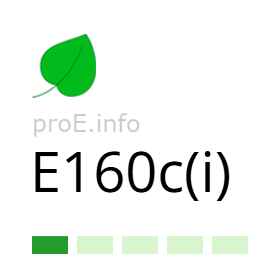
Other names for the additive (synonyms)
General Information
Paprika oleoresin (additive E160c(i)) is one of the forms of the additive E160c and belongs to the broader group of additives E160, which includes carotenoid colorants of natural origin.
Paprika oleoresin is an oily extract derived from the ripe fruits of paprika (Capsicum annuum), obtained by solvent extraction (typically using hexane or carbon dioxide). It is standardized by pigment content, primarily capsanthin and capsorubin, and appears as a thick red-brown liquid.
The main component of additive E160c(i) is capsanthin. It also contains capsorubin, β-carotene, zeaxanthin, lutein, and other carotenoids. Traces of capsaicin, responsible for pungency, may also be present.
The colorant E160c(i) is obtained by extracting dried and ground paprika using organic solvents. The resulting extract is then purified and dissolved in vegetable oil (e.g. sunflower or soybean oil).
Physicochemical properties of paprika oleoresin compared to natural paprika powder:
- insoluble in water,
- well soluble in fats and oils,
- resistant to heat processing and light.
Paprika oleoresin as the food additive E160c(i) is used as a fat-soluble colorant in cheese, sausages, margarine, oils, sauces, snacks, as well as in cosmetics and animal feed.
For more information about properties, health effects, scientific studies, and legal regulations, see the general description of additives E160c and E160.